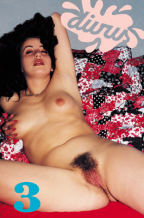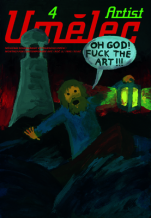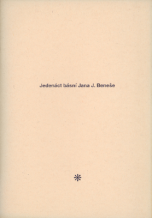| Revista Umělec 2002/1 >> After the Coup | Lista de todas las ediciones | ||||||||||||
|
|||||||||||||
After the CoupRevista Umělec 2002/101.01.2002 Leonor Nuridsany | scene | en cs |
|||||||||||||
|
"Every single Czech has a mobile phone.
It strikes you immediately when you come to Prague. From businessmen to students, from children to parents, everybody’s got one. Why? One possible explanation goes that under communism the waiting list to get a landline was so long that waiting several years to get one was the norm. Mobile phones have solved that particular problem — now nobody waits. This is the Czech Republic today, is an ongoing mix of habits from the old regime and the new ethos of a neo-liberal capitalism. This split is also reflected in the newer and older generations of artists. During the 1960s and 70s artists had no choice but to exhibit in underground venues or even in hidden fields in the countryside. “Culture” was a tool of the ruling ideology. Today’s artists would refuse to exhibit in underground places, least of all in fields. They want acknowledged visibility. At all costs. All too aware of this fact, managers of exhibition spaces abuse their position to push through their own ideas. They know interesting spaces in Prague are a rare commodity and that artists are ready to alter their work, to partially finance the exhibition or to hand over a piece to the collection of the gallery, simply to get exhibited. These conditions, unacceptable in France, are alas commonplace in Prague. There is no alternative but to accept the demands of gallery managers or get out. A clear sign that the art market is blurred are the words used to label spaces for contemporary art. One talks about “commercial galleries” or “non-commercial spaces.” The former is by definition a commercial entity, but what is at stake is the prejudice that galleries are institutional and follow the law of the market. These commercial spaces are not as interesting as the non-commercial spaces that work independently and therefore tend to show higher quality works. But let’s not go so quickly. Beyond the quality achieved thanks to the great effort of those managing such non-commercial spaces, one has to mention that these non-institutional spaces also benefit from grants from the Ministry of Culture, the City of Prague and other Czech and foreign institutions. Prague’s non-commercial spaces can be split into two types, exhibition halls and independent cultural centers. Jaroslav Krbůšek’s exhibtion hall Galerie Václav Špála, well known for the quality of its exhibitions of Czech artists, ranks among the very few places where one can discover the work of an unknown young artist showing for the first time. Galerie Václav Špála is affiliated with the Foundation for the Funding of Czech Art, as are other galleries throughout the Czech Republic. As a condition for being exhibited, artists are asked to donate one of their works to benefit the foundation, which can then decide to sell it or keep it in its collection. Is this acceptable? Is it not shocking? In France, it would definitely not be done. But in the Czech Republic it is, for some, an excessive demand, for others it is the right of the gallery and at least an open “rule of the game” — the key to getting exhibited in a quality space. This practice and its collateral problems can be found in other smaller, less important spaces; spaces that are much liked by young Czech artists. The Foundation and Center for Contemporary Art at Jelení, among others, also shows first timers. Located in the premises of the former Soros Center, the twenty-square-meter Jelení gallery presents a new young Czech artist every month. For each exhibition a brochure or a prospectus showing the artist’s work is made — no small effort. The Jelení gallery is one among the small group of spaces dedicated to contemporary art: the National Gallery, City Gallery, Galerie Václav Špála, the galleries MXM and Jiří Švestka and the alternative spaces NoD and Display. In the heart of the city, NoD claims predominance over other alternative spaces in Prague. NoD was founded in 1999 and run until recently by Kryštof Kintera. Into this pleasantly grungy interior, he first brought lively and original performances. With the large exhibition space, the theatre scene, the café in the corner to make you feel welcome, a few computers to surf the Internet free of charge, the needs of a growing audience are well catered to. The team running the space may have changed, but the space has not, and on the ground floor, Roxy, Prague’s leading alternative nightclub, continues to put on concerts of rock and electronic music. Kintera says his departure from NoD has allowed him to get back into making art, as running NoD was devouring all his time. Those who were at Manifesta in Luxembourg may remember his shapely objects, vibrant and curvy, neatly set on a fur carpet, hedged by their packaging and manual. All of which looked genuinely useful, though a closer look revealed how unusual and funny his the objects really were. A finalist for the Jindřich Chalupecký prize, Kintera was showing his current work in the National Gallery while I was there: little human figures, sketched in different positions, stenciled in different places within the museum and captioned Hear Me, Famous, Keep Dreams or Money Everywhere? They perfectly suited this public space. Created last September, Display Gallery is the new kid on the block, and it differs from the others due to its openness and the collaboration work it does with Central European institutions. Display survives, like any other exhibition space in Prague, thanks to subsidies from the Czech Ministry of Culture and also thanks to the low rent kindly set by the local town hall The one condition is that the space shall not become commercial. In the future Display will also ask for financial help from foreign institutions to co-finance exhibitions. David Kulhánek is one of Display’s founding members. He says he’d been inspired by alternative exhibition spaces in Berlin that put on shows, performances, concerts and nights of experimental film. Display is still in an early phase and is just getting its program off the ground, but because it is fairly new, it has attracted much interest and hope, among young artists and curators. Another of the founding members, Zbyněk Baladrán, is also an artist. Why is that so? Is it that artists are better able to direct galleries, art centers and alternative spaces? Since last year, Baldarán has taken pictures, mixed models, written fiction and painted. Cinema is clearly influential in his work. Like a puppet theatre, a painting is a background, a stone represents a mountain, a folded piece of cloth is a knoll. Baldarán’s work is a poem made from crumbs. His sequence of photos entitled Forest is also strongly influenced by the movies. These images blend the countryside and the movie set. He took pictures of the back stage of a set with its wooden beams and potted trees. It’s impossible to tell if the decor is set in the forest or if the forest is part of the decor. We don’t even know if this is really decor since the main elements (camera, cables, lights and people) are all missing. The last place we could define as an art center is also a residence for artists, a gallery, a movie theater, a concert hall, artist studios, a café… And it has yet to be built. A huge, decaying meat factory was donated by a generous patron to artist David Černý. Should everything go right, he plans on opening his new center sometime next year. David Černý is provocative and busy. Without a doubt. Characteristics that can be found in his full-size plastic sculptures and his do-it-yourself kits of a rock-star, a raped woman, Jesus Christ, etc. Or in his bronze sculpture of a man hanging from a long metal bar. Černý provokes to get a reaction, to force reflection on his country’s socio-political history and offer an amused look at the world around us. But David Černý is more than a provocateur and his Meat Factory project is a testament to this. Commercial galleries worth mentioning are rare. Let’s mention two. MXM gallery was established in 1990 and immediately acknowledged as a key space, focusing on painting. Galerie Jiří Švestka was founded in 1995 by Jiří Švestka. The Švestka gallery is appealing to the West, both in terms of who exhibits and buys there. Prior to opening his gallery, Jiří Švestka headed Dusseldorf’s Kunstverein for fifteen years. His long stay in Germany has given him the ability to master the trickier ends of the art market, and allowed him to build an extensive network in the European and American art world. The Švestka gallery makes a living through selling contemporary art pieces, which amounts to about half of the gallery’s inventory. This is achieved mainly via connections with contemporary art collectors and the gallery’s representatives in Berlin and London. Jiří Švestka, and everybody else too, considers the art market in the Czech Republic practically non-existent. Besides the obvious lack of serious collectors, the biggest obstacle lies in a lack of interest. Those with money prefer to invest it in modern art or design. However, artists unable to make a living with their work are often able find income within the art scene, maybe even more so than in other parts of the world. Still hopeful of selling abroad, efforts are being made to build an outside network with Central or Western Europe and the United States. Michal Koleček, founding member of the Emil Filla Gallery in Ústí nad Labem, an industrial town close to the German border, states that: “Since the beginning of the 90s, the Czech art scene has looked down on any relationship with other post-communist countries. It has progressively closed in upon itself. And if we look back, we can clearly see that in every important exhibition of post-communist contemporary art, the Czech Republic is either absent or badly represented. We are not surprised when we see how few exhibitions of contemporary art have been organized by Czech institutions during the 90s; neither are we surprised how rarely they participated in events abroad.” But things are changing, slowly. The most important location for modern and contemporary art is the National Gallery. Sta-nislav Kolíbal, perhaps the most famous living Czech constructivist, was responsible for the architectural design of the collections. The modern art collection includes a unique selection of French masterpieces bought at the turn of the last century by a gifted amateur and, incidentally, one of the former directors of the National Gallery, Vincent Kramář. Temporary exhibits are regularly organized and recently it was Andy Warhol’s turn, the famous artist with Slovak roots, as we all know. Part of the museum is dedicated to young artists and exhibitions — but alas, too few and seldom. These shows are organized by curators Tomáš Pospiszyl, Stanislav Kolíbal and director of the National Gallery, Milan Knížák, the unconventional artist who took part in the Fluxus movement abroad in the 1960s and is now seen as a contentious rogue. The museum also offers its premises for the exhibition of the work of the finalists of the Jindřich Chalupecký prize (100,000 crowns and a three-month stay in California). This year the Jindřich Chalupecký prize went to Tomáš Vaněk, and it didn’t go unnoticed. His exhibition in the National Gallery showed stenciled reproductions of the work of the popular and well-known Czech artist Josef Lada, to which Vaněk added simple and often unnoticeable sexual innuendo. Not everybody liked the idea, as Lada’s work has become sacrosanct, nd Vaněk’s work was immediately censored. Wittily enough, the artist put an end to the debacle by organizing a debate focused on the questions of copyright, reproduction, quotation and the caricature of a work of art. Chalupecký laureate Jiří Příhoda works with optical illusion to break down the ways in which we perceive day-to-day reality. Once in the National Gallery he showed a long box and invited spectators to enter. At the back, a bright blue light fell from above. The ceiling was a thick, wavy blue sea. The viewer was gripped within this ideal, frightening atmosphere. An exhibition in 1998 in the Špála gallery was based on the same principle of blurred perception. At first glance, the gallery seemed empty. A closer look showed that something was wrong with the stairs at the back of the gallery. Slightly too steep… In reality, Příhoda had halved the space of the gallery while perfectly reproducing it. To be perfect, the illusion relied on the architecture recreated by the artist and the truncated perspective. The visitor was banned from coming in. Do Czech artists claim to be part of the same movement? Can we observe the use of a particular medium? This doesn’t seem to be the case. Artists here probe the medium of realistic figuration as well as surrealism and social commentary. They often use several media at the same time: photography, video, performance. Others continue with painting. Here, as well as in other countries, there is a clear movement towards painting. Artists can be split equally into users of new media and painters, Jan Mančuška, Krištof Kintera, Jiří Příhoda and Zbyněk Baladrán are bound to use installation and video. Jiří Černický or Michal Pěchouček would be more on the side of painting and photography. Michal Pěchouček is not your typical artist. Rarely are the artist and the work bound so tightly and so well. His little photo-novellas walk the fine line between childhood poetry and perversity, showing scenes both witty and absurd. His videos are even more interesting. Occasionally they tell their stories at normal speed; other times they stop on an image, like memory flashes. He has a sense of rhythm and narration and reveals his perversity, convincing young girls to let themselves be photographed as fast-food waitresses, not letting us know what happens next… We can only guess. One major surprise on my trip to Prague was to discover that the Ministry of Culture is also responsible for religious affairs. Then I started to notice the peculiar relationship of artist to faith, especially to the Hussite experience, which could explain a certain individualism and reticence, as opposed to Hungary, for example, where social relationships with artists are more natural. On the other hand, although the communist regime subsidized its “culture” to enforce its own political agenda and tolerated a consensual “humanist” culture, the savage capitalism that has replaced it hasn’t brought much. What contemporary Czech art lacks more than anything is roots with its history, its ancestors, its supporters (Stanislav Kolíbal, Adriena Šimotová, Václav Boštík, Karel Malich) and an openness to the winds of the high seas. Some understand this all too well. And are working at it. Right now. Translated by Rémi Diligent "
01.01.2002
Artículos recomendados
|
|||||||||||||
|
04.02.2020 10:17
Letošní 50. ročník Art Basel přilákal celkem 93 000 návštěvníků a sběratelů z 80 zemí světa. 290 prémiových galerií představilo umělecká díla od počátku 20. století až po současnost. Hlavní sektor přehlídky, tradičně v prvním patře výstavního prostoru, představil 232 předních galerií z celého světa nabízející umění nejvyšší kvality. Veletrh ukázal vzestupný trend prodeje prostřednictvím galerií jak soukromým sbírkám, tak i institucím. Kromě hlavního veletrhu stály za návštěvu i ty přidružené: Volta, Liste a Photo Basel, k tomu doprovodné programy a výstavy v místních institucích, které kvalitou daleko přesahují hranice města tj. Kunsthalle Basel, Kunstmuseum, Tinguely muzeum nebo Fondation Beyeler.
|











































 New book by I.M.Jirous in English at our online bookshop.
New book by I.M.Jirous in English at our online bookshop.
Comentarios
Actualmente no hay comentariosAgregar nuevo comentario